Culture and Identity
OUTCOMES
Cultural diversity is fostered. People have the right to express different cultural values and practices and to pass cultural traditions on to future generations. Our national identity reflects the values and aspirations of Māori, European/Pākehā, Pacific peoples and other groups and communities.
INTRODUCTION
Culture and identity are about understanding the history and cultural traditions that have shaped us and about continuing to endorse cultural practices and explorations. New Zealand society is culturally diverse, and becoming more so through changing immigration patterns. There is an indigenous Māori population and a large well-established European/Pākehā population. There are families of Pacific peoples who have lived here for many generations as well as more recent immigrants from the Pacific. Some New Zealanders of Asian origin are from families who travelled here in the 1800s and more Asian people have arrived here in recent years along with other groups.
One of the indicators of the well-being of our society is the approach we take to the cultural diversity of the population and the value placed on exploring our cultural traditions. The way we are presented through the main avenues for cultural engagement (the media, the cinema, publications, art forms and exhibitions) demonstrates our engagement with diversity and our cultural confidence. Aspects of some of these are measurable and these potential indicators are included in this chapter.
People need the skills and opportunities to express their cultural values and practices and to pass these on to future generations should they want to. A good example is that full participation in Māori society relies on competence in Māori language. As well as being integral to the expression of Māori culture, Māori is not only an official language but is unique to New Zealand, and part of our identity in the wider world. How we nurture the Māori language within New Zealand and the opportunities provided for people to maintain their own languages are among the ways we support New Zealand's culture and identity.
Positive engagement with cultural practice, artistic pursuits and respect for cultural diversity are important aspects of a healthy society. How well we understand and tolerate others' needs to celebrate their culture is directly linked to how safe our society feels for its members and is an indicator of whether or not we respect human rights and are free of discrimination.
KEY POINTS
- Participation in culture and arts activities helps to define who we are as New Zealanders and allows us to express and maintain a sense of identity. A high proportion of New Zealanders participate in arts and cultural activities with some of the most popular being reading and listening to music. Overall, women participate more than men, and younger people more than older people. Māori and Pacific peoples take part in more activities, on average, than other groups.
- The proportion of Māori language speakers gives some indication of the health of Māori language. Approximately a quarter of Māori, and a very small proportion of others, are fluent enough to hold a conversation in Māori about everyday things. Older Māori are more likely to be able to converse in Māori than younger people, and figure prominently among fluent speakers.
- Māori medium and Pacific medium models of education have been developed by Māori and Pacific peoples. Particularly strong growth has been seen in kōhanga reo, Māori medium education for pre-schoolers. There has been an increase in the proportion of Māori school students who receive some of their education in the Māori language during the 1990s. In 2000, 1,370 children were receiving their education in a Pacific language. For over three-quarters of them that language was Samoan.
- Local content on New Zealand television is programmes, usually New Zealand made, that reflect our culture and identity. Local content has increased as a proportion of prime time television over the past decade. News and current affairs make up the largest portion of local content programming, followed by information programmes, sports, children's programmes and documentaries. Māori programmes make up less than five per cent of local content.
SUMMARY
Culture and identity are linked. They include the knowledge of our own cultural traditions, and the ability to engage with contemporary cultural practices, along with respect for and acceptance of other cultural traditions.
New Zealanders have high levels of participation in arts and cultural activities. Many participate in arts, heritage and cultural activities, although available data does not show whether this involvement has changed over time.
Māori language is a cornerstone of Māori culture. The proportion of Māori speakers has declined over the last century. Approximately a quarter of Māori are now able to hold a conversation in Māori, with a much smaller proportion regarding themselves as fluent speakers. Māori medium education in the pre-school and primary school years has blossomed in the last 10 years with around a quarter of young Māori children now receiving some instruction in Māori. This may lead to an increase in the proportion of adult Māori speakers.
Local content on New Zealand television has increased over the past decade. However, a high proportion is made up of news, current affairs, information and sports programmes. There is little Māori content.
These indicators suggest that New Zealanders are interested in their culture and identity, and that Māori and Pacific peoples in particular seek ways to express and develop their culture. The indicators in this chapter are not all ideal and require further discussion. Future reports could include indicators such as employment in the cultural sector as well as local content on radio and in cinema as well as on television.
Participation in cultural and arts activities
DEFINITION
The proportion of the adult population who participated in an arts or cultural activity over the course of a year, and the average number of different types of arts activity in which they took part, as measured by the 1997-98 survey of arts participation.
RELEVANCE
Arts and cultural activities are an integral part of our lives and help to define who we are as New Zealanders. People participate in the arts for a wide variety of reasons: for enjoyment and entertainment; for personal growth and development; as a means of expression; to learn new skills and meet new people; to pass on cultural traditions; and to earn an income.
CURRENT LEVEL (NO TREND DATA AVAILABLE)
Over the 1997-98 year, 93 per cent of New Zealanders (2.37 million adults) took part in arts and cultural activities, with an average of five different types of art and cultural activities each. The most popular types of arts activities were reading, and listening to music. Other arts in the top 10 activities were knitting, story telling, design arts and singing. About one in eight New Zealand adults took part in specifically Māori arts and cultural activities, and more than half were non-Māori. The most common activities were waiata, karakia, te reo and kapa haka.
One in 20 adults participated in Pacific arts and cultural activities and more than half were from other cultural groups.
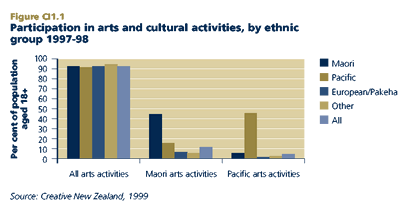
GENDER AND AGE DIFFERENCES
Overall, women were more likely to participate in arts and cultural activities than men (97 per cent compared with 90 per cent). Of those who did not take part, women were more likely than men to say that disability, lack of money or lack of knowledge or skills was the reason, while men were more likely to say they were not interested or would rather play sport.
Young people aged 18-24 years had higher levels of participation in arts and cultural activities than people over 25 (97 per cent compared with 93 per cent). Young people of any ethnic group were more likely than older people to take part in Māori and Pacific arts and cultural activities. People aged 25-44 were most likely to say they did not have time to participate in these activities, while those aged 60 and over were most likely to give disability as the reason for their lack of participation.
ETHNIC DIFFERENCES
Participation in general arts activities was similar for all ethnic groups (over 90 per cent), but Māori and Pacific peoples took part in more activities, on average, than other groups. Over the 1997/98 year, nearly half of Māori (45 per cent) took part in at least one Māori arts or cultural activity. Māori women and those aged 45-59 had the highest level of participation (50 per cent). The key reasons for taking part were enjoyment, and to maintain and pass on skills and traditions. Māori were more likely than other groups to be involved in arts and cultural activities as a student or teacher.
A similar proportion of Pacific peoples took part in Pacific arts and cultural activities (46 per cent). Again, women and older people were the most likely to take part, though young people also had relatively high levels. The most common reason for participating was as a leisure activity.
Reading was one of the top three activities for all cultural groups, but was slightly less popular among Māori and Pacific peoples. Māori and Pacific peoples were more likely than other groups to take part in cultural and arts activities with family or whānau.
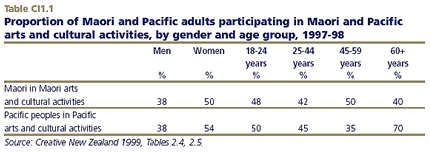
Māori language speakers
DEFINITION
The number of Māori who reported in the 1996 Census that they could hold a conversation about everyday things in Māori, as a proportion of the Māori population
RELEVANCE
As a central component of Māori culture, Māori language is an important aspect of participation and identity. The Māori language forms part of the broader cultural identity and heritage of New Zealand and in 1987 was granted the status of an official language of New Zealand.
CURRENT LEVEL (NO TREND DATA AVAILABLE)
The 1996 Census showed that one-quarter of all Māori (25 per cent) and 27 per cent of Māori aged 15 and over stated that they could hold a conversation in Māori about everyday things.
The Census data does not show how fluent Māori speakers are. Information on the fluency of Māori speakers is available from a national survey of Māori adults (aged 16 and over), conducted in 1995. This showed that, while 59 per cent of Māori stated they could speak some Māori, 43 per cent had low fluency, eight per cent had medium fluency and only eight per cent had high fluency. The proportion who could hold a conversation in Māori (26 per cent) was similar to the 1996 Census proportion for Māori adults. High fluency speakers were likely to be older, with 73 per cent aged 45 and over.
ETHNIC DIFFERENCES
The 1996 Census showed that 84 per cent of the 153,700 who said they could hold a conversation in Māori identified with the Māori ethnic group. A further 12 per cent were European/Pākehā while three per cent identified as Pacific peoples.

The proportion of Māori who were fluent Māori speakers declined markedly over the last century, particularly following the rapid urbanisation of the Māori population in the 1950s and 1960s. The first national Māori language survey in 1973 estimated that the proportion of fluent speakers had fallen to 18 per cent.
AGE AND GENDER DIFFERENCES
Older Māori are considerably more likely than younger Māori to be able to converse about everyday things in Māori. In the 1996 Census, more than half of Māori aged over 60 reported having conversational fluency in the Māori language, compared with less than a quarter of Māori under 40. The 20-39 year age group had the lowest proportion of Māori speakers.
Gender differences in the proportion of Māori language speakers were also apparent. At ages 30-64, males were more likely than females to be Māori language speakers. The reverse was evident at younger ages, with a higher proportion of Māori speakers among females. Among non-Māori, the proportion of Māori language speakers was higher at the younger ages. Females were also more likely to be Māori language speakers than males.

REGIONAL DIFFERENCES
Māori who live in areas with a high proportion of Māori residents are the most likely to be Māori language speakers. Regions with higher than average proportions of Māori with conversational Māori skills were Gisborne (34 per cent), Bay of Plenty (32 per cent), Northland (29 per cent), Hawkes Bay and Waikato (27 per cent). A similar pattern was apparent among non-Māori speakers of Māori.
Māori and Pacific children receiving Māori medium and Pacific medium education
DEFINITION
The proportion of Māori and Pacific children enrolled in early childhood education programmes or schools, who are receiving Māori medium or Pacific medium education in which all or some curriculum subjects are taught in their respective languages.
RELEVANCE
Knowledge of language is an important prerequisite for participating in one's culture and maintaining cultural identity. Māori and Pacific communities have initiated language programmes to develop the language skills of their young people.
CURRENT LEVEL AND TRENDS
<>In July 2000, the 11,400 Māori children enrolled in kō<>hanga reo (Māori "language nests") made up 35 per cent of all Māori enrolments in early childhood education. Although Māori children's participation in early childhood education has continued to rise over time, the share of enrolments in kohanga reo has declined from 49 per cent in 1993. However, the proportion of Māori in services with less than 50 per cent Māori medium has been rising. When all pre-school Mā<>ori medium education programmes are taken into account, the majority (84 per cent) of Mā<>ori children enrolled in early childhood education attend centres that provide at least some Mā<>ori medium experience4. The 4,400 Pacific children enrolled in Pacific language nests in July 2000 accounted for 41 per cent of all Pacific enrolments in early childhood education at that time, down from 46 per cent in 1992.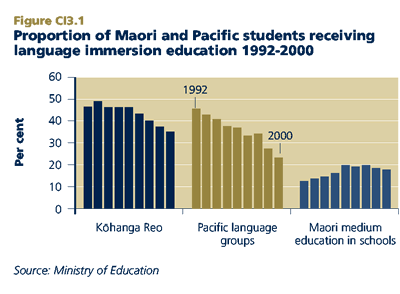
In 2000, 18 per cent of Māori school students (26,357) were involved in Māori medium education. The number of mainstream schools offering Māori medium education increased significantly following the introduction in 1989 of targeted funding to promote the Māori language. By 1996, 20 per cent of Māori students (27,669) were receiving some of their education in the Māori language, a substantial increase from 13 per cent (16,051) in 1992. Kura kaupapa Māori are schools in which Māori language, culture and values predominate and in which the principal language of instruction is Māori. During the 1990s, the number of kura kaupapa Māori grew from 13 to 59. Over the same period, the number of Māori enrolments in kura kaupapa Māori increased until, in 2000, three per cent of Māori students were enrolled in kura kaupapa Māori.

Information on Pacific medium education for school age children was collected for the first time in 2000. A total of 1,370 children were involved in Pacific medium education programmes offered by 16 schools. Most schools offered one language, three offered two, and one school offered four languages. Over three-quarters of students involved in Pacific medium education are receiving instruction in Samoan.
REGIONAL DIFFERENCES
Involvement in Māori medium education is particularly high in the Bay of Plenty, Hawkes Bay, and Gisborne regions, where almost three in 10 students are receiving some school instruction in Māori. Other regions with high levels of involvement are Waikato, Northland, Manawatu/Whanganui and Wellington. A similar pattern holds for kōhanga reo enrolments. Southland has a much higher proportion ōhanga reo enrolments than other South Island regions.
Local content programming on New Zealand television
DEFINITION
The number of hours of local content screened on New Zealand television channels during prime time, as a proportion of the total prime time schedule, between 1988 and 2000. Local content is generally defined as material that is both predominantly made in New Zealand and reflective of New Zealand identity and culture.
RELEVANCE
Television plays a dominant role in our lives. Ninety eight per cent of New Zealand households have at least one television set. For many people, television is a major source of news, information and entertainment and strongly influences their sense of local and national identity. A local content measure reflects the extent to which we see our culture reflected through this medium
CURRENT LEVEL AND TRENDS
In 2000, local content on the three main free-to-air channels comprised 37 per cent of the prime time schedule. The amount of local content rose from 24 per cent in 1988 to a peak of 41 per cent in 1994, before dropping to 35 per cent in 1995. 2000 also saw a decrease in the hours of repeat screenings and an increase in the hours of "first-run" local content television. Since 1988, other free-to-air broadcasters (including TV4, MTV and a number of regional channels) as well as pay-television channels Sky (satellite) and Saturn (cable) have joined the three national television channels. There is little information as yet about whether this will increase the proportion of local content on television.
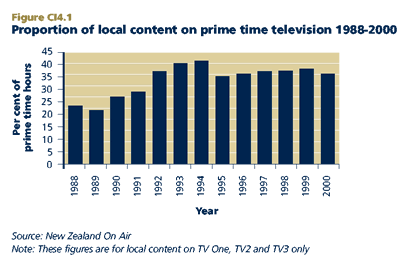
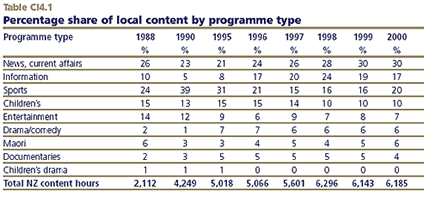
The three programme types that account for nearly two-thirds of local content hours are news and current affairs (30 per cent), sports (20 per cent) and information programmes (17 per cent). Children's programmes account for 10 per cent of local content, entertainment for seven per cent, and drama/comedy account for six per cent. Māori programming tends to constitute about six per cent of New Zealand content overall.
INTERNATIONAL COMPARISONS
International comparisons are difficult due to inconsistencies in measurement approaches by different countries. Available figures suggest that while local content on New Zealand television is steadily increasing, it accounts for less than a quarter of total transmission time, compared to Canada (60 per cent), Norway (56 per cent), Finland (55 per cent), Australia (55 per cent) and Ireland (41 per cent).
